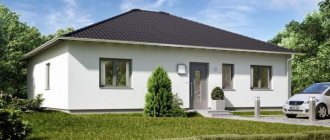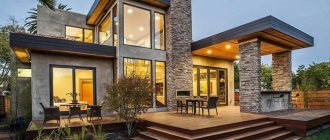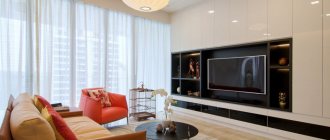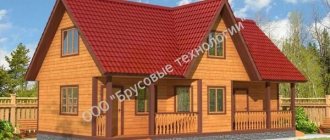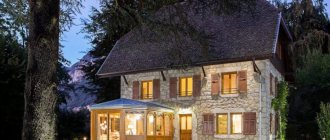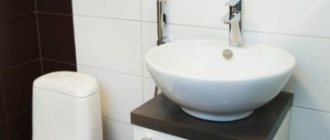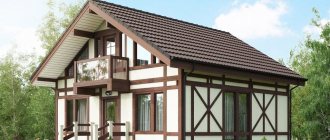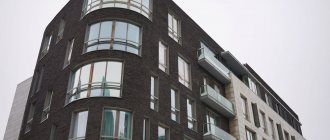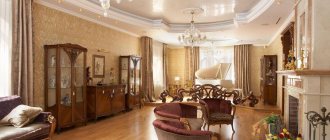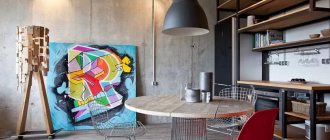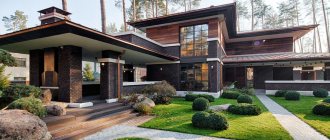Not a single homeowner will argue with the fact that the appearance of a home is the face of its owners. The way the façade of the building is designed, the color palette in which it is decorated and in what stylistic direction it is decorated directly determines the impression not only of the owners’ position in society, their taste preferences, but even of the style and rhythm of life. The use of modern style to decorate the exterior of a building, on the one hand, provides the owners of the house with a fairly wide range of opportunities for choosing building and finishing materials, but on the other hand, it imposes certain restrictions on decorating the facade. Let's together try to understand the features of the modern style of design of the facades of private houses of urban and country type.
No. 1. Classic style
Despite the emergence of many interesting modern architectural styles, the classic remains popular because it creates the impression of solidity and emphasizes the refined taste of the home owner. The style is suitable for large houses, and its main features are:
- symmetry and clarity of forms, regular layout, proportionality and harmony;
- Decorative elements are definitely present, but they are not very pretentious. Particular attention is paid to balustrades and columns;
- Mostly natural materials are used: plaster and marble for walls, natural tiles for roofing, forged metal for fences and gratings.
Beautiful exteriors of brick houses - photo of a brick house
The beautiful exteriors of brick houses take us to Britain or the USA, where such projects are common in great variety. You can recall the loft style with its simple forms, flat roof and panoramic windows.
But it’s worth considering a more decorative format, where brick is combined with gypsum stucco and complemented with columns. Despite this, the project does not accept the abundance of decor and pomp. On the contrary, straight lines are preserved, conservatism and the monumental signature of the architect are present.
No. 2. Baroque
The Baroque style is pretentiousness, pomp, and abundance of decor. The direction is not so often used in modern construction - usually only its individual features :
- combination of straight and curved shapes;
- an abundance of columns, pilasters, sculptures, gilding and other decorative elements to emphasize the status of the owner of the house;
- Pastel shades are predominantly used, as well as burgundy, green, and red.
Interior of the castle
When choosing a medieval style, you do not need to plunge headlong into the atmosphere of past centuries and completely abandon the benefits of civilization. It is better to equip the living space in such a way that it would be as comfortable as possible for a modern person to be within the walls of a house that looks like an impenetrable fortress. To do this, you will have to carefully think through the layout, lower the boiler room and storage room into the basement for storing food and things. The entire first floor will be used for public purposes, and a living room, dining room, and kitchen will be organized here. Move the bedrooms upstairs and there, if space allows, create another living room.
Open plan is the best solution for a castle style interior Source i2.wp.com
It is important to think through the interior of the castle down to the smallest detail. This applies to everything: furniture, decor, lighting. Since there is a lot of natural stone and wood in the decoration, the rooms turn out to be dark. Artificial lighting helps correct this. In the Middle Ages, rooms were illuminated with candles and lamps. Today they can be replaced with a central chandelier made of forged metal. Wall sconces made of the same material will also look good. There are lamps on sale whose shape imitates the shape of antique candlesticks. In them, real flames are replaced by the glow of small light bulbs. It is ideal for creating soft diffused light.
Artificial lighting makes a dark room more comfortable Source yandex.net
Furniture helps to emphasize the chosen style. The classics take root best here: a soft group upholstered in carpet fabric, tables and chairs with slightly aged surfaces, cabinets and chests of drawers made of solid wood. Every castle used to have a large wooden chest lined with metal. It acted as a bed; things were transported in it when moving. Today chests are more decorative in nature. But they can be part of a stylized interior.
Chest as a coffee table Source queen-meble.pl
Modern design items will introduce an imbalance that will immediately catch your eye and cause a slight feeling of rejection. Therefore, it is so important to have the right attitude when purchasing sets for the bedroom, living room and kitchen.
Kitchen units made of solid wood and furniture upholstered in leather are best suited for decorating a castle interior Source beehomeplan.com
No. 3. Modern
Having appeared at the turn of the 19th and 20th centuries, the Art Nouveau style still has many fans, because it allowed us to completely rethink the view of architecture, abandon severity in favor of ornate, fancy forms , but without losing a sense of proportion.
Distinctive features:
- an abundance of smooth curving lines, which manifests itself in the shape of windows, doors, roofs and other elements. Symmetry gives way to naturalness;
- Both traditional and new materials are used in decoration; glazed ceramic tiles, mosaics and stained glass occupy a special place;
- the facade of a house in the Art Nouveau style is often decorated with floral motifs;
- the internal layout is usually complex, with numerous turns, descents and ascents, the rooms are grouped around a hall, which is particularly large.
The direction is used in the construction of private country houses, as well as small houses for several families. There are entire cottage villages in which all buildings are made in this style. However, it is not easy to design such a house correctly, because Art Nouveau is a style of the past, it is difficult to feel it, capturing its character, so the architect has a greater risk of crossing the line and creating something that is only vaguely reminiscent of Art Nouveau.
Casa Batllo
An example of early 20th century Art Nouveau architecture, built in 1877. In 1904-1906, the building was completely rebuilt by the brilliant architect Antonio Gaudi. Both the façade and interiors were reconstructed.
Due to the many design techniques used, the building stands out for its stylistic heterogeneity and is a real Barcelona landmark. The exterior of the house is distinguished by glass mosaic decor, a predominance of asymmetry, natural motifs, religious symbols, colorful pure colors, balconies with railings in the form of the pelvic bones of the human skeleton. Gaudi radically rebuilt the seven-level structure, giving the façade smooth shapes and the roof the silhouette of the arched back of a dragon.
No. 4. Minimalism
Minimalism is one of the most popular modern styles for private homes . As in the interior, minimalism involves the use of only necessary and functionally significant details, so buildings are characterized by strict forms and an almost complete absence of decor . Other features include:
- conciseness, adherence to the rules of composition, simplicity, use of only the most necessary, versatility of each element, rigor and geometricity of forms;
- preference is given to natural materials, incl. stone, wood and glass;
- no hints of pretentiousness or complex finishing elements;
- uniform color scheme, mostly light shades;
- built-in lighting around the perimeter of the house and the presence of large windows, floor-to-ceiling glazing in the living room.
Minimalism in architecture is reduced to a minimum of details, a maximum of light and space.
Color palette for façade design
We use contrasting combinations
Light walls combined with dark window frames and contrasting dark roof tiles look modern and stylish. Against the backdrop of a clear blue sky and green spaces, such combinations look impressive. As contrasting colors, you can use a combination of white, light beige and gray with dark wood grain, black and dark brown shades.
Bright accents for a modern facade
Modern style reveres light shades, the use of various tones of gray, and contrasting black and white combinations. But bright accents are not alien to modern style. The easiest way to create a non-trivial, memorable image is to use bright colors in small structural elements - frames of large windows, entrance doors, rainwater drainage systems.
Bright colors can also be used to decorate some surfaces of the house - the roof or accent walls. To combine with a colorful tone, you need to choose a neutral color - white or gray. No one will miss such a building and will remember it for a long time. In a series of buildings of the same type, a bright facade will stand out, decorating the surrounding picture.
In harmony with nature
The use of natural shades in the design of the facade creates an image of a home that harmoniously fits into the surrounding landscape. The easiest way to create an organic integration of the structure into the surrounding “picture” is to use natural materials or their effective imitation. The exterior of the building can be decorated with a combination of stonework, wooden surfaces or panels in warm, natural tones.
Snow-white buildings
White color is incredibly popular not only for decorating the interior of private houses and apartments, but also for creating the facades of private households. It is especially effective to use white color, which perfectly reflects the sun's rays, in southern regions with a hot climate. Against the background of the blue sky and green plants, snow-white buildings look stunning, solemn, but at the same time light.
No. 5. High tech
The high-tech style in its pure form is not often used in the construction of a private house - usually only some of its elements are taken, combined with a similar-spirited minimalism. The movement arose under the influence of industrial architecture, which explains its main features:
- strict straight lines, restraint and conciseness, almost complete absence of decor and the presence of protruding structural elements;
- the main color is gray, silver-metallic and similar shades. High-tech metal has a special place;
- the presence of large glazed areas;
- If in the interior hi-tech is a demonstration of advanced technologies and modern electronics, then in architecture it is the latest engineering solutions, the predominance of chromed metal, as well as glass, plastic and less often wood.
Design features of a wooden house
Specialists who select interior styles for a wooden house highlight the following features of this work:
- Houses built from wood, as a rule, do not need interior wall decoration, since the texture of the main material fits perfectly into any interior.
- Very often, designers, when working on the interior style of a country wooden house, try to preserve and play with the natural structure of wood.
- With the help of tinting and color correction of wood, you can create the desired atmosphere in the room (for example, fill it with warmth and comfort), as well as decorate the interior in the desired style. So, by bleaching the logs and covering them with varnish, you will add rural motifs to the decoration.
- The interior design of a wooden house, made in pastel colors, is typical of the Provencal style.
- In addition to wooden walls, the room traditionally contains other surfaces made of this material: ceiling wooden beams, laminate, parquet or regular plank flooring.
- Natural stone, which is characterized by its high strength and long service life, goes very well with wood surfaces. The coziness created by the warm wooden texture will be enhanced many times over if you complement the interior with comfortable pieces of furniture and a fireplace.
Thanks to its natural attractiveness, the interior of a wooden house can evoke a special dreamy mood in the inhabitants of the home and give a state of peace of mind. The natural grain of wood adds elegance and beauty to surfaces and makes the room unique.
Coordination of work
You need to choose furniture in accordance with the interior style of the wooden house. Very often, experts suggest furnishing a house with objects also made of wood. With this approach, the interior and furniture will be perfectly combined, and the room itself will be filled with comfort and warmth.
If the furniture has been carefully chosen and positioned, it will further emphasize the sophistication of natural wood. From this point of view, wooden furniture is the ideal option; moreover, it allows you to achieve complete harmony between the decor and the interior. The owner of such a home will demonstrate his status and excellent taste to his guests without words.
No. 6. Chalet style
There are a number of trends that were formed under the influence of the architectural features of individual countries and regions. This includes English, Scandinavian, American, German, Belgian and other styles, but we will start with the chalet style, which is also called Alpine . The trend was born in the French Alps, and initially a chalet was understood as a massive and reliable dwelling made of timber in order to hide from bad weather in the mountains. Such a house will look especially natural on hilly, mountainous and wooded areas.
Main features:
- gable flat roofs that protrude far beyond the house. In the mountains, this technique is necessary to protect the surrounding area from snow. There are cozy balconies under the overhanging roof, and the second floor is an attic. In addition, the Alpine style is characterized by the presence of large terraces without fences that extend beyond the perimeter of the house;
- natural materials are used for cladding the facade: the first floor is faced with stone, the second floor with wood, the roof is made of natural tiles or shingles;
- All details and decorative elements are of an applied and functional nature.
Empire and French classicism
In France, Classicism arose later than in England. Its first phase covers the period from 1750 to 1800. It is expressed in the style of “Louis XVI,” which included the completion of Rococo and the birth of French Classicism.
Classicism in 18th century architecture in France. Church of St. Genevieve, Paris
The second stage is known as the Empire style or Late Classicism, which was distinguished by the solemnity and pomp of memorial architecture and palace interiors.
His other name is
- Imperial style, from the French word empire - empire,
- High classicism or
- Napoleonic style (by period of reign).
The Empire style completes the evolution of classicism in the first three decades of the 19th century.
Arc de Triomphe in Paris.
Its differences - pomp, pomposity, ostentation, festivity - were actively used by Napoleon's French court architects. Appeared in Russia under Alexander I. Correspondences:
- In Britain - Regency style,
- in Germany - Biedermeier or Biedermeier,
- in the USA - federal style.
Watch the video on the topic:
No. 7. English style
This architectural style, like everything English, is distinguished by restraint and aristocracy. The houses turn out to be nice, inspire a feeling of comfort and reliability, and entire cottage communities are built in a similar direction.
Main features:
- a symmetrical rectangular foreground of the house with a slight projection of the roof and windows of the same size, doors with panels, and pilasters around the doors;
- true English style involves the use of only red brick, but today it is often combined with white brick and stone;
- a strict facade, practically devoid of decorative elements, and the main and integral decoration of an English-style house is, of course, a neatly trimmed lawn and flower beds.
Victorian style in architecture
The style originated between 1830 and 1910 during the reign of Queen Victoria. Key features: “dollhouse” effect, thoughtful finishing, steep mansard roof covered with tiles, asymmetrical shape, presence of a porch, bright rich colors, balconies with columns, majestic towers and turrets, decorative railings.
Victorian houses are typically two-storey compact buildings with intricate decoration and multi-stage pitched roofs, often decorated with spiers. The stylistic movement originated in Great Britain and spread not only within the country, but also to the English colonies. Houses in this architectural style are distinguished by an asymmetrical facade. For finishing within the stylistic direction, plaster, siding, and brick are used.
No. 8. Italian style
An Italian-style house will look good both in coastal regions and in areas with dense vegetation. There are no requirements for the size of the building - the main thing is to convey an atmosphere of comfort, peace and relaxation.
Main features:
- flat or almost flat roof, the presence of a terrace with a canopy, shutters on the windows;
- the facade is finished with brick or plaster in light shades, the roof is made of natural terracotta-colored tiles or other materials that look similar to them (flexible tiles and metal tiles);
- decorative elements have a functional meaning. For example, brackets that support the roof. The balconies and terraces feature landscaping, attractive furniture and lamps.
Rococo
The birthplace of this style is France, where it appeared at the beginning of the 18th century. Rococo is distinguished by lightness, friendliness, and playfulness. Architecture completely arbitrarily combines and distributes parts of a structure, without thinking about the forms and their appropriateness. There is no strict symmetry, but there is an endless selection of numerous ornamental details and their division.
The complete lack of rationality in handling the arrangement and harmonious combination of elements, the capriciousness, sophistication and burden of forms on Rococo monuments makes them original and monstrous. The masterpieces of Rococo architecture in Italy, Germany, and England have their own differences. They remind us of the times when powdered wigs, flies, blush and whitewash were in fashion.
Helbling House in Innsbruck, Austria. Photo by James Davis/Corbis
Read more in the article Rococo in architecture: you need to know this. Rococo masterpieces in Italy are described briefly on the Zen Architecture channel, and there is also a description of Rococo monuments in England and in German architecture.
No. 9. Russian style
Beautiful log cabins with an abundance of decorative carved elements, like those once owned by wealthy merchants, emphasize the status of the owner and his pride in his roots and origins. A house in a traditional Russian style is an expensive pleasure, but, on the other hand, such a house gives a feeling of complete security and comfort.
Character traits:
- To build a house, a wooden frame is used, but today, to reduce the cost of construction, it is often replaced with a block house - it looks the same in appearance, but is much simpler to install. The base can be made of stone or brick, but here you can be guided by regional characteristics, because different parts of the country have formed their own traditions in home improvement;
- The structural elements of the house also play a decorative role, because they are made with relief or through carvings. It is present on shutters, platbands, roof overhangs, fences;
- Each house in the Russian style is unique, no two are alike.
Examples of modern styles of houses and cottages
In total, there are more than 40 styles in its pure form for building a country house. Added to this number is a large number of mixed architectural movements. The choice of a specific style often depends on the size of the home.
For example, if you build a small home with ambitious marble columns at the entrance or high arched windows, it will create disharmony. All elements must be proportional and visually balanced. To understand what a home should be like, let’s consider several popular style options.
Provence
Cottages or private houses in the Provence style have a unique harmony of charm, love for everything traditional, conservative and rural simplicity. Inside, the wooden beams are completely exposed. They are painted, varnished or whitewashed.
Interior of a wooden house in Provence style - beams, white painted ceiling and wall surfaces Source arxip.com
Exterior design may vary, but it always evokes quiet rural life. Some houses are simply brick or stone without finishing. Others are plastered, painted in light colors and decorated with contrasting elements of the protruding frame. The following solutions are very popular:
- white walls and blue frame beams and window shutters;
- beige stonework and light brown roofing.
A whitewashed or white-painted house in the Provence style Source michaelzingraf.com
Characteristic features of the exteriors of houses in Provence:
- Mandatory presence of windows with projections directly from the roofs (bay windows). There are also fancy options where such a window occupies part of the facade wall and part of the roof along the vertical plane.
- Chimneys of fireplaces or stoves run along the side external walls.
- The shape of door and window openings is simple straight or arched.
- A small terrace, balcony or veranda is allowed.
When building houses in the Provence style, only natural building materials must be used. This is wood, stone, clay, ceramic tiles, whitewash. The house must have neat garden paths paved. Everything is decorated with a large number of baskets and pots with fresh flowers.
The simplicity of the stonework peeking out from under the plaster, high chimneys, bay windows - classic Provence Source domikarkas.ru
Classical
The classic style of architecture of a country house or cottage can also be called European. Strictness of form, lack of frills in decor, simplicity and functionality are the main things that distinguish this solution from others.
Style features:
- The shape of the building is square, rectangular.
- Decor - complex bay windows of the attic floors, inserts and stones, lanterns or lamps.
- The roof can be either 2 or 4 pitched.
- Number of floors - from 1 to 3-4 floors (also ground floor).
- Roofing material – metal tiles.
- The shape of windows and doorways is straight or arched.
- The window size is average.
- The facade finishing material is facing brick, plaster.
The cladding of the ground floor is laid out with stone, the rest of the house is plastered or painted.
A house in a classic style has strict straight and orderly lines, simple designs, neutral tones and a minimum of decor. Source avk-project.com
See also: Catalog of projects of houses and cottages presented at the exhibition “Low-Rise Country”.
Modern
The style of the exterior of country houses arose at the junction of times - the end of the 19th and beginning of the 20th centuries. He is still loved by those who are accustomed to adhering to a sense of proportion in everything. Projects for such dwellings may already allow ornate decor or contours of facade elements to dilute strict lines.
The facade of the house is made with interesting three-level smooth curves, complemented by an interesting edging - white stucco. Source fotostrana.ru
Features in detail:
- Suitable for large and small families.
- Creative people will like it.
- Filling the design with smooth lines, curves, and rounded corners, where possible, is encouraged here.
- The contrast of shades is complemented by a third color. It focuses attention on a specific area.
- Instead of symmetry, a tendency towards naturalness is used.
- Finishing materials – brick, stone, tiles (glazed ceramics), plaster, paint, stained glass and mosaics.
- Decor – stucco with plant and animal ornaments, forged metal elements.
- Complex internal layout - grouping of rooms around a large hall.
Rounding is used in arched structures of windows and doorways. Grace finds itself in the design of barriers for balconies, steps, and stairs. The columns of the terraces or the front entrance can be asymmetrical in shape with smooth curves. An interesting approach to roofing - some parts of the house have a dome-shaped roof, where its edges hang directly onto the walls.
The house is designed with a lot of smoothly curved surfaces Source moreremonta.info
The color scheme of houses or cottages in the Art Nouveau style is filled with calm, but always contrasting shades. The following combinations are popular now:
- dark brown, muted yellow and brown with a hint of burgundy;
- red brick, white plaster and bluish stucco on a light background;
- completely monochromatic light facade and massive dark roof;
- a play of all shades of brown - from light to dark, complemented by gold-tinted glass;
- sand facade, cream foundation and decorative framing of arched passages, door frames, windows.
The result is an ideal combination of brevity, geometric shapes and fancy solutions (turrets, round windows, graceful steps).
Chalet
The style of a country house - chalet - is characterized by a combination of stonework, brick and wooden elements. The name comes from the French Alps. The first “chalets” were small buildings that provided short shelter from the winter cold in the mountains. Subsequently, they became typical multi-level village houses, which are installed on an uneven mountainous surface.
A building on a stone foundation with a completely wooden second floor Source uutvdome.ru
See also: Catalog of companies that specialize in the design and construction of turnkey country houses.
Main differences:
- Fits well into hilly, mountainous and wooded landscapes.
- The lower part is made of stone, the upper part is made of wood or trimmed with solid wood.
- The roof is always gable with a canopy hanging strongly in front. This helps protect your home from snow storms.
- The roof covering is tiles made from natural materials or shingles made from heavy-duty tree species (larch, cedar).
- Wall decoration - facing with wild stone, brick or rough whitewash.
- The presence of terraces and balconies on supports. Everything is made from wood.
- Some projects include large panoramic windows, others have small ones with shutters, typical for a village home.
- Profiles of double-glazed windows are made of wood only.
- Number of storeys – 2 and less often 3-storey houses and cottages.
Style has its own directions. They were formed under the influence of ethnicity, culture, and climate of different Western countries. The following chalet options are available:
- Scandinavian;
- Belgian;
- German;
- English;
- American.
Modern design of a multi-level house in the German chalet style, typical for mountainous and hilly areas Source avatars.mds.yandex.net
The second name, which summarizes all the mentioned branches, is Alpine style. Everything here is so practical that even the decor is practical. For example, the crossbars of balcony barriers are often used for hanging flower pots on them in the warm season. Wooden profiles and beams - for hanging street lamps on them, and kitchen utensils indoors.
Russian architectural style
A cottage or private country house in the Russian style must be built from strong logs. If such a solution turns out to be too expensive, then new generation technologies are used - block houses. Thanks to this solution, the house is also built from wood, but with the imitation of a full-fledged log house.
The house can be completely wooden. But there are options when the ground floor is made of stone or brick. Russians have long had large families. The lower tier always housed the so-called public rooms - for example, a large kitchen. The lower tier is the basement or first floor, depending on the regional characteristics of the soil and climate.
Wood is also usually used as decor. These are various threaded elements - pillars, barriers, facade balusters (for steps, balconies, terraces). Wooden shutters are always decorated with typical carvings, repeating Russian ornaments, plant, animal or fairy-tale patterns.
A log house with a spacious terrace, extended from the facade into the distance, decorated with wood carvings, pillars and shutters Source avatars.mds.yandex.net
Interestingly, the carving can be either voluminous, relief, or through. The last option from a distance strongly resembles lace. Such decorating techniques are used to decorate cornices, brackets or roof overhangs, fences, and interfloor overhangs. No two houses are alike. Every Russian home is unique.
Roman style
Monastic or fortress styles of country houses over time transformed into a solid and massive Romanesque style. Here you can easily discern the fusion of several directions - the classics of the Renaissance, Gothic and the fortified inaccessibility of the chateau.
House-palace with Gothic elements when arranging the roof. The chateau style is given away by the castle tower and chimneys Source avatars.mds.yandex.net
Features of the Romanesque concept:
- Everything is made of rough stones.
- The exterior decoration is modest, without decoration. Everything resembles a fortress or a fort.
- Architectural forms tend towards rigor without frills.
- The walls and roof are massive.
- The window openings are narrow.
- The steps are recessed under the arches and run between the pillars.
- Hexagonal, round, and other roof options are covered with tiles.
- The shades of the façade are always close to natural.
Often such houses are decorated with entwined ivy, interesting balusters of balconies, and a few stone statues. All outbuildings must be attached to the house.
No. 10. Scandinavian style
The Scandinavian style in the harsh domestic climate is of particular interest. Such houses are based on functionality, natural materials, and the absence of bright, pretentious details, because the main thing is to maintain warmth inside the building and repel the harsh elements.
Main features:
- simplicity and conciseness, the main thing is that the house gives a feeling of comfort and coziness. Scandinavian houses are rarely large - they are compact, have one or two floors;
- the ground floor and basement are often missing, but you can’t do without an open terrace or a spacious porch;
- the roof is flat or gable, made of natural tiles or their artificial substitutes, the walls are finished with wood, light shades are usually used, but dark red color is also suitable. A modern Scandinavian-style house requires large window openings, because it should be very light inside.
Idea
Even architecture could not do without philosophers. What is the idea of a classic?
For starters, philosophers changed the idea of beauty. Before that, in Gothic, Romanesque and partly Renaissance, beauty was a person’s perception of this object.
That is, horses are considered beautiful not because they are objectively beautiful, but because many people consider them beautiful. The main idea in the classics is that beauty is a property of an object, and not a product of the viewer’s perception.
Since beauty is real and not figurative, then it must obey the laws of nature. Beauty is the law of nature, and the law should be as simple as possible. What could be simpler than straight lines? The idea of classics is order, compliance with all proportions, symmetry. If it's a line, then it's straight. If it's an angle, then it's 90 degrees.
We come to the conclusion that art and science are inseparable. Science serves art, and art depicts the laws of science. Then art simply cannot afford to go against science and common sense. A wavy line is illogical, unscientific and cannot exist in the art of classicism.
Having compared all these ideas, philosophers and architects came to the conclusion that such creations already exist. Ancient masters almost completely implemented the philosophy of naturalness, simplicity and harmony. And they called themselves successors, heirs of the ancient style. Hence the name - classic. Immortal ideas.
No. 11. Half-timbered
During the Middle Ages, half-timbered houses were built throughout almost all of Europe, but they were especially popular in Bavaria. Their main feature is that the frame of the house is not hidden, but is put on public display . It is made of powerful wooden beams, the space between which was once filled with a mixture of clay and reeds, plastered and painted. The frame beams create a unique pattern and can be laid out in the form of geometric shapes, flowers, crosses, etc. Today the technology has received some modern features, but the main characteristics remain unchanged:
- the basis and decoration of the house is a wooden frame;
- The facade is made in light shades, the finishing material is plaster, which goes well with wood and stone. The latter is often used for cladding the base;
- the roof is made of tiles, shingles or their imitation;
- modern half-timbered houses have large panoramic windows, but today they are used in almost all styles, because multi-chamber double-glazed windows do not allow heat to freely escape to the street, not like centuries ago.
Loft style in architecture
The birthplace of non-standard trends in the interior and exterior design of houses is the USA. Initially, these were factories, warehouses, factories, converted into residential premises. Loft objects have an industrial, authentic look.
Conceptual features of the architectural style:
- Dirty gray, red-brown color scheme and metallic shades.
- Strict lines and simplicity of geometric shapes with minimal decoration.
- Fragments of industrial structures in the form of metal stairs, factory pipes, ventilation systems.
- Unusual combinations of aged red brick and panoramic glazing, raw or roughly plastered concrete and ferrous metal for a residential building.
Loft-style houses are preferred by creative individuals with an unconventional approach to life. Architectural objects that claim to belong to the Loft are distinguished by extraordinary exteriors that refer to the industrial past.
No. 12. European style
Domestic architects sometimes operate with such a concept as European style. It has absorbed the basic features of the house-building features of a number of European countries, but does not have any specific features that make it possible to determine a clear affiliation with any region. The result is a conservative, strict style, not devoid of decor.
Main features:
- regular geometric shapes, a predominance of rectangular and square shapes, but there is a place for unpretentious decor (stone inserts, beautiful lamps, complicated bay windows);
- two- or four-pitched roof made of natural or metal tiles;
- small or medium-sized square or arched windows;
- The facade is made of plaster, the base and windows can be decorated with stone.
Green, organic architecture
Green building seeks to minimize the negative impact of construction on nature. This movement strives for moderate and efficient use of materials, energy and space with the goal of organic development of the ecological system as a whole. The key factor of green architecture: the use of environmentally friendly technologies and resources at every stage of construction, from idea and planning to demolition.
Green architecture. Office building, Malaga, Spain
The 20th century architect F.L. Wright was the first to use the term “organic architecture,” formulated its principles and adhered to them in his works. He knew how to combine the wishes of customers with the uniqueness of the environment. You can be convinced of this by getting acquainted with examples of the work of a talented master.
But no less (and maybe more) organic is the architecture of another great architect, Antonio Gaudi. He was inspired by the forms observed in nature and transferred them to his creations. The Sagrada Familia is a prime example of this.
No. 13. American style
The American style was formed on the basis of the European one, but acquired special and unique features. It is based on the desire of the settlers to demonstrate the wealth of the house, so the building turns into a whole complex with a complex roof shape . An American house is traditionally made using frame technology, but in the domestic space the technology has been slightly modified, giving preference to walls made of brick and foam block. Today this style is especially popular, and entire villages are being built with such houses.
Main features:
- numerous cascades of roofs, combined under one roof of premises with different functional purposes. The garage is always built-in or attached, the windows are large, often with shutters, the terraces are spacious, often L-shaped and encircle the house;
- materials for facade cladding - light plaster, stone, wood;
- Columns that support the canopy over the terrace act as decorative elements. The style requires a minimum of decor, but does not look simple or primitive, since large terraces, complex roofs and natural materials are already decoration;
- Usually there is no ground floor or basement.
Exterior of a one-story house: how to live simply and tastefully
Are you the owner of a one-story house? Even if you are planning to build a house from scratch, you need to know:
- The exterior of a one-story house requires maximum space saving. The size of the windows should not be too small. Their number on one wall should not exceed 2-3. It is best to choose windows on 50-70% of the wall.
- Brick, wood panels, siding, decorative stone, and a variety of plaster are used as facing materials.
- To make the house seem larger and give a feeling of space, you should select light and pastel colors of the facade. It is recommended to add some color accent (as shown in the photo).
No. 14. Prairie style, or Wright style
The style is named after the American architect F.L. Wright, who is called one of the most controversial. He has a lot of discoveries and bold decisions to his name; he believed that a house should not have complex details, because they would distract from nature, and the building should complement the environment. The simplicity of lines that characterized the houses he built became a feature of the new style. Due to the predominance of horizontal lines and surfaces, the direction received a second name - prairie style .
Main features:
- flat and hipped roofs with wide overhangs, united by a common horizontal window element;
- the house dissolves as much as possible into the landscape, the boundaries between indoors and outdoors are erased, which is achieved not only by the predominance of horizontal surfaces, but also due to massive glazing;
- The facade is made of brick, wood, stone, it is possible to use wooden elements. The decor is minimal.
Provence
The Provence style in a wooden house originates from the French province and is inspired by nature. It is distinguished by the use of natural materials and decoration with fresh flowers. A Provence-style design in a wooden house combines lightness of shape with pastel colors, which allows it to be combined with the country style. A wooden house is perfect for finishing in the French style.
Its main feature is to emphasize the lightness and subtlety of lines. The color palette gives preference to warm, muted tones. The exterior decoration is dominated by natural materials that can create an emphasis on the beauty of the chosen style. The interior is full of forged items, perfect for decoration.
A wooden house built according to an individual project can characterize its owner. Modern houses made of wood, the popularity of which is increasing every year, are not only environmentally friendly and comfortable, but also high-tech. Architectural styles of such buildings arose quite a long time ago in different countries. Some styles can be combined with each other, but only an experienced specialist can do this.
No. 15. Castle style (medieval style)
Looking ahead, we note that this style is far from the most popular today. Some call it too pretentious, others call it unreasonably expensive. It is suitable mainly for large houses . As a compromise, you can use only individual style elements. The architects, by the way, gave the direction another name - Disney style.
Main features:
- massiveness and high walls. The feeling of monumentality is achieved through the intricate asymmetrical composition of the facade, large forms and the absence of architectural frills. The presence of balconies, terraces, turrets is welcome;
- complex roof shape, because often the house is large and consists of several parts;
- the façade is faced with stone, brick, or less often with plaster. To reduce the cost of construction, artificial materials that closely imitate natural ones are used;
- windows are arched or rectangular, doors can be decorated with forging or stained glass.
Architectural styles of the Archaic period
Ancient Egyptian style
This style gave rise to a huge variety of architectural structures and great monuments. The architecture of Ancient Egypt, including the palaces, temples at Luxor and the pyramids on the Nile River, is evidence of one of the world's most remarkable civilizations. The predominant building materials are sun-baked brick, limestone, sandstone and granite.
Architecture of Ancient Egypt: Pyramids of Giza
Modern people's understanding of the ancient Egyptian style is based on surviving religious temples and massive structures of unknown purpose, with characteristic sloping walls with a small number of openings, surrounded by mystery. It is widely believed that these are tombs, but there are other theories. Additional architecture details
- Ancient Egypt,
- Egyptian pyramids,
- temples
No. 16. Gothic style
Gothic in the European architectural tradition replaced the castle style, so it is not surprising that these two styles have much in common. Monasteries, cathedrals and palaces were built throughout Europe in the Gothic style. The Gothic style in its pure form is not for a private home, but if you really like the direction, then you can use some of its elements , and only if the house is large enough.
Main features:
- the predominance of vertical lines and sharp elements - such houses seem to stretch upward;
- arches and windows have pointed tops;
- the facade is decorated with towers, columns, numerous sculptures, bas-reliefs, carved details and large stained glass windows.
Tver
Hotel Galyani on the corner of Volodarsky and Pushkinskaya streets.
Cathedral of the Ascension on Sovetskaya Street.
The building of the Junker Cavalry School on Zhigarev Street.
No. 17. Renaissance
Architecture in the Renaissance style is moderation in everything: simplicity and laconism of lines, together with thoughtful, unpretentious decor, allows you to create cozy, well-made houses.
Main features:
- clarity of shapes, symmetry in the arrangement of windows, the presence of numerous superstructures and columns supporting the roof or balcony of the second floor. Preference is given to rectangular and semicircular shapes;
- presence of a patio;
- finishing is done in light colors of plaster and stone.
Rustica
In Latin rusticus means rustic, rough, uncouth. Yes, the roots of this style are so old that they are lost somewhere in Ancient Rome. And, although initially rusticism meant a rough stone finish, modern architects include brutal wooden houses hand-cut or made from rounded logs of large cross-section to this style.
Rusticism is becoming increasingly popular among city dwellers seeking simplicity and unity with nature as opposed to concrete and asphalt life in the metropolis. If this idea is close to you, then these projects will definitely appeal to you:
House project S-177 from Ecohome
Bathhouse project B-65 from Ecohome
No. 18. East style
The fashion for the oriental has affected not only the kitchen - often cottage villages today decorate houses, when looking at which anyone will definitely guess - this is an oriental style. Its main features:
- roof with slopes curved upward. In the east, they believe that this form of roofing helps protect the house from evil spirits;
- use of natural materials, including wood and stone;
- the presence of a large terrace along the contour of the house;
- well-maintained local area.
Yaroslavl
An example of a classic here would be Sovetskaya Square, namely the building of the Provincial Government Offices. Built in 1787 in record time per year. This is the first such monumental building in Yaroslavl, because it is the main government building of a large center, they could not have built it otherwise.
On Pervomaiskaya Street you can find Gostiny Dvor. Built in the first quarter of the 19th century to replace the open market. He suffered from fires, reconstruction and shelling during the Second World War. The entire historical concept can no longer be seen, but the rotunda and the preserved northern wing will help you see and understand classicism.
No. 19. Art Deco
Art Deco combines elements of Art Nouveau, Empire style, as well as Egyptian and African motifs. The result is a unique, slightly pretentious and recognizable style.
Main features:
- a combination of straight, strict lines with broken and rounded ones, the use of geometric shapes in the design of the facade;
- the presence of ethnic patterns, arches, spiers;
- pastel natural shades;
- natural materials, incl. wood, stone, brick, ceramics, metal, glass.
Examples of creative solutions within the framework of modern style
The modern style of decorating the facades of private houses is multifaceted and diverse. Design ideas will always find a way to express themselves even within the framework of an existing concept. We bring to your attention several original design plans for private households that attract attention with one or another outstanding techniques of architectural, constructive and design solutions.
Siding: advantages and disadvantages
Another common option for facade finishing now is the so-called siding, which consists of vinyl or metal panels. Among the advantages of this solution, I would also like to mention a wide range of colors, an attractive price and ease of installation, which can be done on your own.
Another significant advantage of such panels is their practicality - they are resistant to temperature loads and very durable. With the right approach, the use of siding can also benefit the visual image of the cottage.
However, this material does not fit well with classical styles. If you want to make your home truly luxurious, reminiscent of the palaces of the past, then you will have to choose some other options over siding. But modern architectural trends interact very effectively with it.
